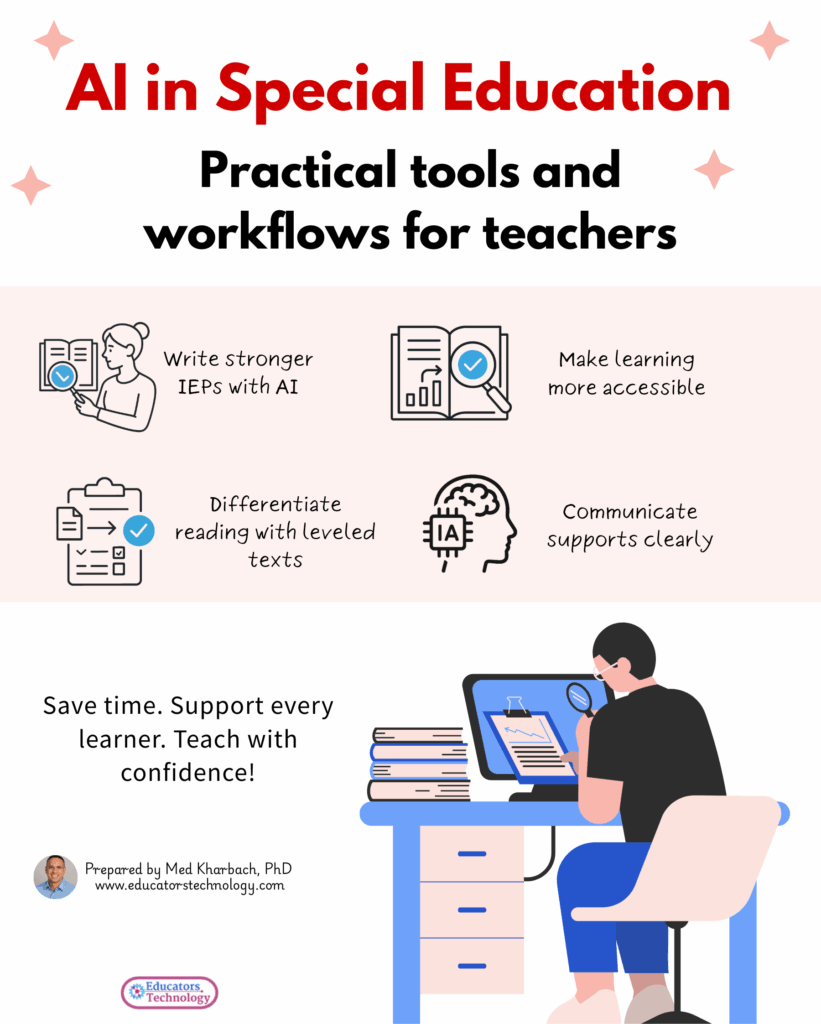Special education is one of the areas where AI shows real, practical promise. For teachers, the challenge has always been time, time to write detailed IEPs, time to adapt materials, time to communicate supports clearly to families. AI tools can help lighten that load, making it easier to individualize learning, remove barriers, and strengthen collaboration with parents.
This guide is organized around four teacher-facing moves you can start using right away:
- Write stronger IEPs with AI
- Make learning more accessible
- Differentiate reading with leveled texts
- Communicate supports clearly
Each section walks you through what to do, which tools work best, and how to keep everything accurate, ethical, and classroom-ready.
EP writing: faster drafts, clearer language
AI can handle the first pass so you can focus on accuracy and individualization. Start by pulling a tight snapshot of present levels, then use an IEP generator to propose goals and supports. Keep your judgment at the center and translate final text for families in plain language.
Tools to use
- MagicSchool IEP Generator, Accommodation Suggestions, Text Rewriter, Email Family
- Gemini EDU or Copilot in your school domain for private rewriting, plain-language versions, and translation
A quick workflow
- Paste present levels into MagicSchool’s IEP Generator and ask for three goal options per area that include criteria, method, schedule, and progress monitoring ideas
- Use Accommodation Suggestions to propose supports grouped by instruction, materials, environment, and assessment
- Edit for fit with your local standards and service guidelines, tightening wording and removing anything you will not implement
- Run the final goal through Gemini EDU or Copilot to produce a family version at Grade 6 to 8 reading level
- Save both versions and note how progress will be measured and stored
Starter prompts you can paste
- Given this student profile and present levels [paste], suggest 6 accommodations grouped by instruction, materials, environment, and assessment. Include a one-sentence why and a classroom example for each
- Draft 3 measurable goals for written expression at Grade 4. Include baseline, criteria, method, schedule, and two progress monitoring probes per goal
- Rewrite this IEP goal in plain language for families at Grade 7 reading level. Keep all measurements and timing. [paste]
Quality checks before you finalize
- Keep numbers, frequency, and methods unchanged when simplifying for families
- Store drafts only in district-approved tools and avoid student identifiers in any non-approved environment
- Add how you will document progress and where that data will live
- Have a colleague glance at the family version for clarity and tone
Related: Tips for Using AI with Students with Special Needs


Turn handouts into audio
Text to speech removes a barrier fast. Students can listen while following along, replay tricky parts, and pair audio with note-taking organizers. You do not need to redesign materials. Open the handout, press Read Aloud, share the audio.
Tools to use
- Microsoft Immersive Reader in Edge and Word for instant Read Aloud, line focus, syllables, and translation.
- NaturalReader EDU for higher quality voices and MP3 export when you want offline files.
A quick workflow
- Open the PDF in Microsoft Edge. Click Enter Immersive Reader. Select Read Aloud. Adjust voice and speed. Turn on line focus if attention support helps.
- If you need an audio file, upload the handout to NaturalReader EDU. Pick a voice. Export MP3. Post the link in your LMS or print a QR code.
Classroom uses
- Post audio with each reading so students can follow along during small group or centers.
- Pair audio with a graphic organizer for main ideas and key details.
- Offer audio as part of accommodations during independent work or assessments that allow read-aloud support.
- Create a quick study set by exporting MP3s for review at home.
Tips for quality and access
- Check reading order. If headings are out of order, open the source in Docs or Word and clean formatting, then re-export the PDF.
- Use clear file names, for example Unit2_Article_Audio.mp3, and store in your LMS folder for easy access.
- Add alt text to images so screen readers provide context.
- Share options. Link in the assignment, add a QR on the printed handout, and show students how to adjust speed and voice.


Speech to text dictation
Dictation lets students produce more writing with less friction. It helps learners with dysgraphia, fine-motor challenges, or processing speed get ideas down quickly. You model the basics once, then students draft by speaking and finish with a short editing pass.
Tools to use
- Google Docs Voice Typing
- Microsoft Word Dictation
A quick workflow
- Set up a quiet spot and check the mic. Model how to say punctuation and new line.
- Google Docs: open a Doc, go to Tools > Voice typing, click the mic to start and stop. Run Spell check.
- Microsoft Word: open Word for web or desktop, Home > Dictate, allow mic access, speak punctuation and simple commands like new line. Use Editor to clean up.
Classroom uses
- Quickwrites and exit tickets without typing fatigue
- Scribing support for students with dysgraphia or injuries
- Brainstorming before a typed or handwritten draft
- Oral responses for assessments that allow alternative formats
Tips for quality and access
- Use a headset mic for better accuracy and reduce background noise
- Coach students to speak in short sentences and pause between ideas
- Teach a fast revision checklist: capitals, punctuation, names, paragraph breaks
- Avoid full names or sensitive details on shared devices
- Pair dictation with a graphic organizer so ideas have structure


Leveled reading and differentiation
AI can create multiple versions of the same text so every student reads the same idea at a level that fits. You pick the article, set the target level, and generate quick checks. This keeps small groups on the same content while giving each learner the right entry point.
Tools to use
- Diffit
- Brisk Teaching Chrome extension
- Eduaide
A quick workflow
- Choose a source. Paste a link, PDF text, or your draft paragraph.
- Set the target level. Grade band, Lexile, or CEFR depending on the tool.
- Generate the passage plus vocabulary and 3 to 5 checks for understanding.
- Skim for accuracy. Fix names, dates, and domain terms.
- Export to Google Docs or PDF and assign by group in your LMS.
Classroom uses
- Same-article sets with three levels for small group reading
- Warm-up reads with quick checks before a discussion or lab
- Homework packets with a family-friendly level included
- Content previews for students who need frontloading of key ideas
Copy-paste prompt
Level this text to Grade [X]. Keep the main ideas, simplify sentences, define 8 domain words with student-friendly meanings, and add 5 comprehension questions that mix recall and inference. [paste text]
Tips for quality and access
- Keep proper nouns, numbers, and quotes accurate after leveling
- Replace any awkward AI phrasing with your voice
- Add a one-sentence purpose at the top so students know what to look for
- Pair leveled text with the same discussion prompt so groups can talk together


Communicate supports clearly with families
Families need clear, jargon-free information about what supports look like in class and how progress will be checked. Use AI to create plain-language explainers, quick summaries after meetings, and translated versions so everyone stays in the loop.
Tools to use
- MagicSchool: Text Rewriter, Text Leveler, Email Family
- Gemini EDU or Copilot in your school domain for plain-language rewrites and translation
- Otter.ai for meeting notes and concise summaries, used under district policy
A quick workflow
- Collect the original text you must keep accurate: goal wording, service minutes, accommodation list
- Paste into MagicSchool Text Rewriter or Gemini EDU and set a target reading level, usually Grade 6 to 8
- Ask for a four-part explainer: what it is, what it looks like, when we use it, why it helps
- Add one classroom example and how progress will be checked
- Translate if needed, then send with MagicSchool Email Family or your district email
- Save a copy to your student documentation system
Classroom uses
- One-page goal explainers families can reference at home
- Accommodation quick sheets, for example quiet testing room or teacher notes provided
- Step-by-step referral overview for new families
- Post-meeting recap with decisions, dates, and next steps
- Multilingual versions for home support
Copy-paste prompts
- Rewrite this IEP goal at Grade 7 reading level. Keep measurements and timing. Add what it looks like in class and how we will check progress. [paste]
- Create a one-page parent explainer for this accommodation. Use four sections: what it is, what it looks like, when we use it, why it helps. [paste]
- Translate this parent explainer into [language]. Keep headings and plain tone. [paste]
- Summarize this meeting into 5 bullet points with decisions and next steps for families. [paste or attach notes]
Tips for quality and access
- Keep numbers, minutes, frequency, and criteria unchanged
- Replace jargon with everyday terms, for example small-group support instead of pull-out
- Use short sentences, clear headings, and white space
- Check tone for warmth and clarity, then have a colleague review any sensitive translations
- Store and share through district-approved tools only, and follow consent rules for recordings and transcripts
Download the PDF version of this guide.







